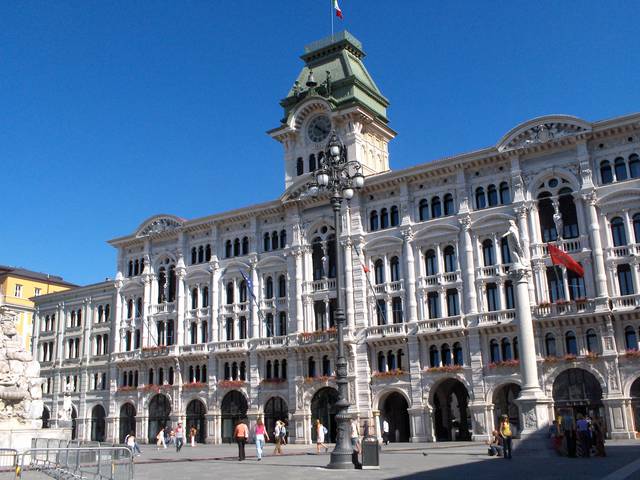
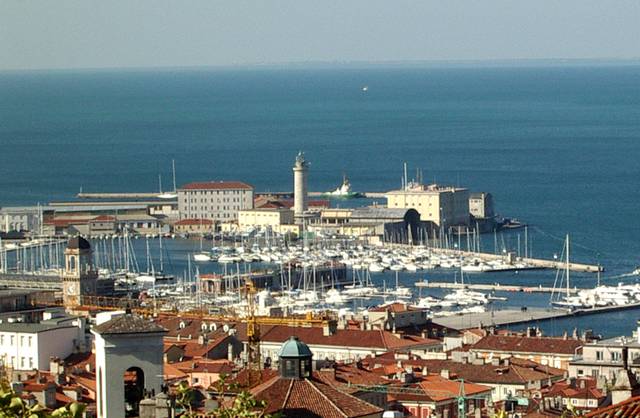 Trieste (Triest in German, Trst in Slovenian and Croatian) is a city in North-East Italy that was once a very influential and powerful centre of politics, literature, music, art and culture under Austrian-Hungarian dominion.
Trieste (Triest in German, Trst in Slovenian and Croatian) is a city in North-East Italy that was once a very influential and powerful centre of politics, literature, music, art and culture under Austrian-Hungarian dominion.
Today, Trieste is often forgotten as tourists head off to the big Italian cities like Rome and Milan and it is a very charming and underestimated city, with a quiet and lovely almost Eastern European atmosphere, several pubs and cafes, some stunning architecture and a beautiful sea view. It was also, for a while, the residence of the famous Irish writer, James Joyce.
Trieste is the capital of the autonomous region of Friuli Venezia Giulia and has over 204,000 inhabitants (2018). It is at the crossroads of several commercial and cultural flows: German middle Europe to the north, Slavic masses and the Balkans to the east, Italy and then Latin countries to the west and the Mediterranean Sea to the south.
Its artistic and cultural heritage is linked to its singular "border town" location. You can find some old Roman architecture (a small theatre near the sea, a nice arch into old city and an interesting Roman museum), Austrian empire architecture across the city centre (similar to stuff you can find in Vienna) and a nice atmosphere of metissage of Mediterranean styles, as Trieste was a very important port during the 18th century.
The region of Friuli Venezia Giulia is officially quadrilingual (Italian, Slovene, Friulian, and German). Signs are often only in Italian in Trieste, as the city is generally Italian speaking and the local dialect (a form of the Venetian language) is called Triestine. Surrounding villages and towns are often inhabited by mostly Slovene speakers. Residents, and those working in the city, can easily find free courses to learn Italian, Slovene, German, English and many other languages. When walking around Trieste, you will also hear Croatian/Serbian all the time, mainly from people who visit the city on brief shopping trips.
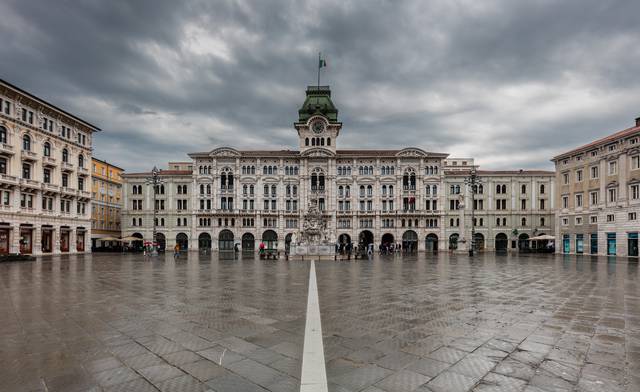 Unlike many other Italian cities, Trieste's all-inclusive tourist pass is well worth the price. The FVG Card can be purchased at the tourist center in Piazza Unita, and includes free access to nearly all the major attractions in the Trieste area, and many in other nearby cities. €18 for 48 hours, €21 for 72 hours, and €29 for 7 days.
Unlike many other Italian cities, Trieste's all-inclusive tourist pass is well worth the price. The FVG Card can be purchased at the tourist center in Piazza Unita, and includes free access to nearly all the major attractions in the Trieste area, and many in other nearby cities. €18 for 48 hours, €21 for 72 hours, and €29 for 7 days.
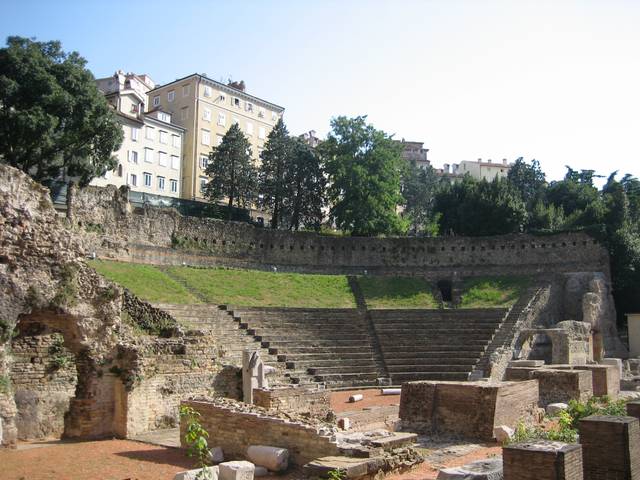
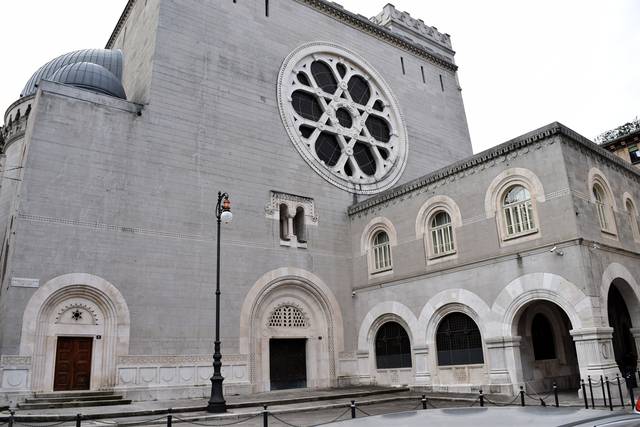
- Città Vecchia. Trieste boasts an extensive old town: there are many very narrow and crooked streets with typical medieval houses. Nearly the entire area is closed to traffic.
- The Austrian Quarter. Half of the city was built under Austrian-Hungarian dominion, so there are a lot of palaces that resemble Vienna. An iconic place of this quarter is the majestic Piazza Unità (Unity Square), which is Europe's largest sea-front square. The most present architecture styles are Neoclassical, Art Nouveau, Eclectic, and Baroque.
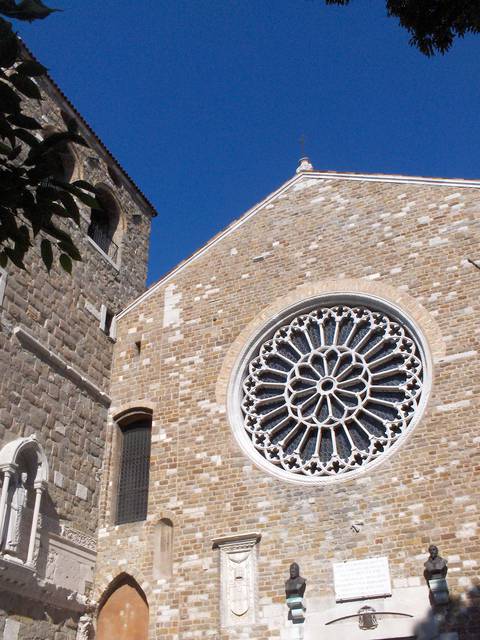
- San Giusto - Cathedral and Castle. A walk on the castle ramparts and bastions gives a complete panorama of the city of Trieste, its hills and the sea.
*Museum
*Capitoline Temple
*Church of San Giovanni
*San Michele al Carnale
*WWI Altar
*Roman forum and civic building
*Castle of San Giusto
*Park of Remembrance World War I commemorative park,
*Lapidary Garden. Contains Roman and Medieval relics discovered in Trieste. In it stands a Cenotaph to the archaeologist Johann Winckelmann, father of neoclassicism, who died in Trieste in 1769.
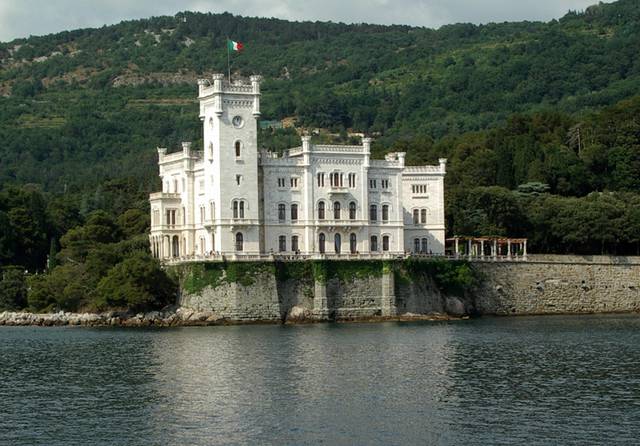
- Miramare Castle. This historic 19th-century castle is a 20-minute trip from Piazza Oberdan on the #6 bus.
*Maximilian's Chambers and those of his consort, Carlota of Belgium; the guest rooms; the information room telling the history of the Castle and the Park's construction.
*Duke Amadeo of Aosta's apartment with furnishings from the 1930s in the Rationalist style.
*Throne Room
*The park offers the public a chance for an interesting stroll among botanical species and an important collection of sculptures dotted along its numerous paths.
*The Stables, a building which was restored and is now used for temporary exhibitions;
*The Old Greenhouses
*Little Castle containing the seat of the Direction of the Natural Marine Reserve of Miramare and a small number of aquariums
- The Roman Theatre. Trieste or Tergeste, which probably dates back to the prehistoric period, was enclosed by walls built in 33-32 BC on Emperor Octavius’s orders. The city developed greatly during the 1st and 2nd century AD. The Roman Theatre lies at the foot of the San Giusto hill, and faces the sea. The construction partially exploits the gentle slope of the hill, and most of the construction work is in stone. The topmost portion of the amphitheatre steps and the stage were presumably made of wood. The statues that adorned the theatre (which was brought to light in the 1930s) are now preserved at the Town Museum. Three inscriptions from the Trajan period mention a certain Q. Petronius Modestus, a person who was closely connected with the development of the theatre, which was erected during the second half of the 1st century.
- Il Faro della Vittoria. The Lighthouse of the Victory, an impressive work of the Triestine architect Arduino Berlam (1880-1946) and of the sculptor Giovanni Mayer (1863-1943), has two important functions. Besides lighting the gulf of Trieste, in order to help navigation, it also serves as a commemorative monument dedicated to the fallen of the First World War. The lighthouse is topped by an embossed copper statue of Victory sculpted by Giovanni Mayer. Under this statue is affixed the anchor of the torpedo-boat Audace (the first Italian ship that entered the port of Trieste on November 3,1918).
- Arco di Riccardo. An Augustan gate built in the Roman walls in 33 AD. It stands in Piazzetta Barbacan, in the narrow streets of the old town.
- Canal Grande. Trieste's beautiful grand canal, just up the street from Piazza Unità. Step onto the bridge to pose with a bronze statue of James Joyce, one of Trieste's many iconic statues that walk the streets instead of standing on pedestals.
Città Vecchia. Trieste boasts an extensive old town: there are many very narrow and crooked streets with typical medieval houses. Nearly the entire area is closed to traffic.
The Austrian Quarter. Half of the city was built under Austrian-Hungarian dominion, so there are a lot of palaces that resemble Vienna. An iconic place of this quarter is the majestic Piazza Unità (Unity Square), which is Europe's largest sea-front square. The most present architecture styles are Neoclassical, Art Nouveau, Eclectic, and Baroque.
San Giusto - Cathedral and Castle. A walk on the castle ramparts and bastions gives a complete panorama of the city of Trieste, its hills and the sea.
*Museum
*Capitoline Temple
*Church of San Giovanni
*San Michele al Carnale
*WWI Altar
*Roman forum and civic building
*Castle of San Giusto
*Park of Remembrance World War I commemorative park,
*Lapidary Garden. Contains Roman and Medieval relics discovered in Trieste. In it stands a Cenotaph to the archaeologist Johann Winckelmann, father of neoclassicism, who died in Trieste in 1769.
Miramare Castle. This historic 19th-century castle is a 20-minute trip from Piazza Oberdan on the #6 bus.
*Maximilian's Chambers and those of his consort, Carlota of Belgium; the guest rooms; the information room telling the history of the Castle and the Park's construction.
*Duke Amadeo of Aosta's apartment with furnishings from the 1930s in the Rationalist style.
*Throne Room
*The park offers the public a chance for an interesting stroll among botanical species and an important collection of sculptures dotted along its numerous paths.
*The Stables, a building which was restored and is now used for temporary exhibitions;
*The Old Greenhouses
*Little Castle containing the seat of the Direction of the Natural Marine Reserve of Miramare and a small number of aquariums
The Roman Theatre. Trieste or Tergeste, which probably dates back to the prehistoric period, was enclosed by walls built in 33-32 BC on Emperor Octavius’s orders. The city developed greatly during the 1st and 2nd century AD. The Roman Theatre lies at the foot of the San Giusto hill, and faces the sea. The construction partially exploits the gentle slope of the hill, and most of the construction work is in stone. The topmost portion of the amphitheatre steps and the stage were presumably made of wood. The statues that adorned the theatre (which was brought to light in the 1930s) are now preserved at the Town Museum. Three inscriptions from the Trajan period mention a certain Q. Petronius Modestus, a person who was closely connected with the development of the theatre, which was erected during the second half of the 1st century.
Il Faro della Vittoria. The Lighthouse of the Victory, an impressive work of the Triestine architect Arduino Berlam (1880-1946) and of the sculptor Giovanni Mayer (1863-1943), has two important functions. Besides lighting the gulf of Trieste, in order to help navigation, it also serves as a commemorative monument dedicated to the fallen of the First World War. The lighthouse is topped by an embossed copper statue of Victory sculpted by Giovanni Mayer. Under this statue is affixed the anchor of the torpedo-boat Audace (the first Italian ship that entered the port of Trieste on November 3,1918).
Arco di Riccardo. An Augustan gate built in the Roman walls in 33 AD. It stands in Piazzetta Barbacan, in the narrow streets of the old town.
Canal Grande. Trieste's beautiful grand canal, just up the street from Piazza Unità. Step onto the bridge to pose with a bronze statue of James Joyce, one of Trieste's many iconic statues that walk the streets instead of standing on pedestals.
- Museo Revoltella, Via Diaz 27. This museum was donated to the city in 1869 by Baron Pasquale Revoltella, a great patron of the arts who liked to surround himself with precious and avant-garde works. In a building restored and extended by architect Carlo Scarpa, the museum today houses one of Italy’s finest collections of 19th-century, modern and contemporary art.
- Museo di Storia, Arte e Orto Lapidario, Piazza della Cattedrale, 1 Trieste. Tu-Su 09:00-18:00. Archaeological, historical and art collections. Prehistoric and protohuman findings of local origin; Roman and medieval sculptures and epigraphs. Egyptian, Greek, Roman and pre-Roman antiques. Numismatic collection. Photograph and book libraries. €5, €3 reduced.
- Museo di Storia Naturale. Zoological, botanical, geological, palaeontological and mineralogical collections. Vivarium. Specialised scientific library.
- Museo della Comunità Ebraica di Trieste "Carlo e Vera Wagner". Collection of ritual art of the Jewish community of Trieste, mainly silverware and fabrics.
- Museo della Risiera di San Sabba. A national monument - a testimonial of the only Nazi extermination camp in Italy.
- Railway Museum Trieste Campo Marzio. Closed since July 18, 2017 for restoration.. Housed in the former railhouse, the museum features drawings, models and fullsized train engines and railcars as well as horse-drawn trams from Trieste's past.
- Museo Sartorio, Largo Papa Giovanni XXIII, 1, +39 040 301479. Tu-Su 10:00-18:00. Art collections donated to the city by the Sartorio family. Paintings from the 19th and 20th centuries; sculptures; sketches by Giambattista Tiepolo. Full: €6; reduced: €4.
Museo Revoltella, Via Diaz 27. This museum was donated to the city in 1869 by Baron Pasquale Revoltella, a great patron of the arts who liked to surround himself with precious and avant-garde works. In a building restored and extended by architect Carlo Scarpa, the museum today houses one of Italy’s finest collections of 19th-century, modern and contemporary art.
Museo di Storia, Arte e Orto Lapidario, Piazza della Cattedrale, 1 Trieste. Tu-Su 09:00-18:00. Archaeological, historical and art collections. Prehistoric and protohuman findings of local origin; Roman and medieval sculptures and epigraphs. Egyptian, Greek, Roman and pre-Roman antiques. Numismatic collection. Photograph and book libraries. €5, €3 reduced.
Museo di Storia Naturale. Zoological, botanical, geological, palaeontological and mineralogical collections. Vivarium. Specialised scientific library.
Museo della Comunità Ebraica di Trieste "Carlo e Vera Wagner". Collection of ritual art of the Jewish community of Trieste, mainly silverware and fabrics.
Museo della Risiera di San Sabba. A national monument - a testimonial of the only Nazi extermination camp in Italy.
Railway Museum Trieste Campo Marzio. Closed since July 18, 2017 for restoration.. Housed in the former railhouse, the museum features drawings, models and fullsized train engines and railcars as well as horse-drawn trams from Trieste's past.
Museo Sartorio, Largo Papa Giovanni XXIII, 1, +39 040 301479. Tu-Su 10:00-18:00. Art collections donated to the city by the Sartorio family. Paintings from the 19th and 20th centuries; sculptures; sketches by Giambattista Tiepolo. Full: €6; reduced: €4.
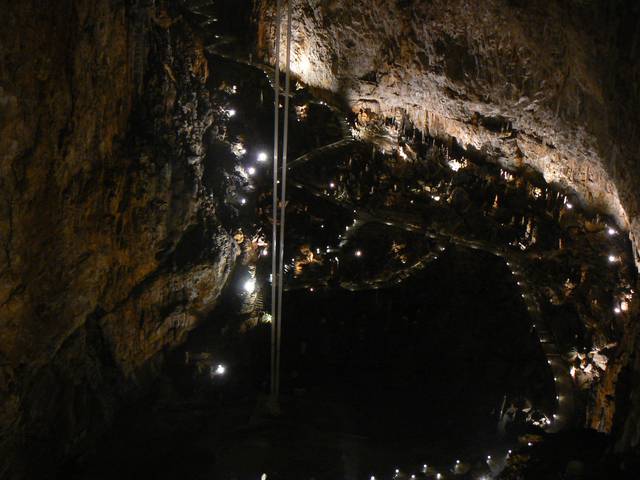
- Grotta Gigante. This giant cave claims to be the biggest tourist cave in the world (since 1997 in the Guinness Book of Records). The enormous hall is 107 m high, 280 m long and 65 m wide. The multi-lingual guided tour takes about 45 minutes. You can also visit the Museum of Speleology is near the cave and besides the various speleological, geological and paleontological finds it also includes some valuable archeological pieces and a poster collection of the cave.
Grotta Gigante. This giant cave claims to be the biggest tourist cave in the world (since 1997 in the Guinness Book of Records). The enormous hall is 107 m high, 280 m long and 65 m wide. The multi-lingual guided tour takes about 45 minutes. You can also visit the Museum of Speleology is near the cave and besides the various speleological, geological and paleontological finds it also includes some valuable archeological pieces and a poster collection of the cave.
- Saint Spyridon Church, 9, Via San Spiridione. Tu-Sa 09:00-12:00, 17:00-20:00; F 09:00-12:00.
- Synagogue of Trieste, +39 040 6726736. Su 10:00-12:00; Th 15:30-17:30. It's one of the largest in Europe, and was built in 1912. Guided tours only.
Saint Spyridon Church, 9, Via San Spiridione. Tu-Sa 09:00-12:00, 17:00-20:00; F 09:00-12:00.
Synagogue of Trieste, +39 040 6726736. Su 10:00-12:00; Th 15:30-17:30. It's one of the largest in Europe, and was built in 1912. Guided tours only.
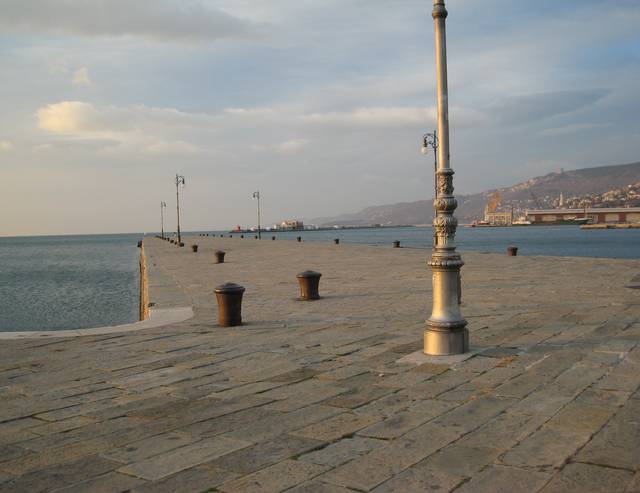
_Il_Lungomare_005-ArLbl.medium.jpg)
- Molo Audace. The long pier across from Piazza Unica d'Italia. An amazing place to relax and watch the sunset.
- The Karst. The limestone plateau above the city on both sides of the border. It is ideal for walking and offers excellent views of the Gulf of Trieste, coastal areas of Slovenia, and northern Croatia. Many of the villages in the Karst are majority-Slovene speaking areas. The principal town in the Karst is Opicina.
* Strada Vicentina. A pedestrian road stretching from Opicina to Prosecco, about 6km long. The views are superb.
- Barcola. Trieste's concrete, sandless beach just south of Miramare. You can sunbathe here.
- Sailing with Discover Friuli, +39 339 7245055. This tour agency offers half-day and full-day sailboat cruises around the Gulf of Trieste, with great views of Duino, Miramare, and the surrounding landscape from the sea. €100-234 depending on length/group size.
Molo Audace. The long pier across from Piazza Unica d'Italia. An amazing place to relax and watch the sunset.
The Karst. The limestone plateau above the city on both sides of the border. It is ideal for walking and offers excellent views of the Gulf of Trieste, coastal areas of Slovenia, and northern Croatia. Many of the villages in the Karst are majority-Slovene speaking areas. The principal town in the Karst is Opicina.
* Strada Vicentina. A pedestrian road stretching from Opicina to Prosecco, about 6km long. The views are superb.
Barcola. Trieste's concrete, sandless beach just south of Miramare. You can sunbathe here.
Sailing with Discover Friuli, +39 339 7245055. This tour agency offers half-day and full-day sailboat cruises around the Gulf of Trieste, with great views of Duino, Miramare, and the surrounding landscape from the sea. €100-234 depending on length/group size.
During the 1970s and 1980s Trieste was the number one shopping destination for tourists from Yugoslavia.
- Ghetto and Piazza Unità. for Biedermeier and Liberty furniture, Bohemian glassware and Austrian silverware, and other fine antiques.
- Glassworks from France and Venice.
- Paintings
- Prints and antique engravings as well as books, postcards, and historical photographs.
Ghetto and Piazza Unità. for Biedermeier and Liberty furniture, Bohemian glassware and Austrian silverware, and other fine antiques.
Glassworks from France and Venice.
Paintings
Prints and antique engravings as well as books, postcards, and historical photographs.
The cuisine of Trieste reflects the living traditions of the many populations that have passed through the city over the centuries. In the city's restaurants, called "buffets", you can find delicious examples of the local Austrian and Slavic tradition.
- Caldaia Traditional dish of boiled pork.
- Jota a soup prepared with pork, potatoes, cabbage, and finely-ground beans
- Gnocchi in the style of Austrian dumplings, made with everything from ham to stuffed with plums.
- Brodetto Fish soup
- Risotto Creamy rice dish
- Sardoni in savor flavored pilchards
- Salads common favorites here include chicory and rocket(arugula)
- Bruscandoli
- Farmers of the plateau who had been allowed by an imperial decree to sell their own products during a period of 8 days, organized the so-called osmizze, where it is possible to taste local wines and products, such as Monrupino's tabor cheese and honey from San Dorligo.
- The pastry shops in Trieste offer delicious local varieties of the most famous Austrian cakes: Sacher torte, krapfen, strucolo cotto and strucolo de pomi (local varieties of strudel), chiffeletti (cookies made with flour, eggs and potatoes and fried in oil)
- During Easter you can taste the pinza, a sweet leavened bread that many women still prepare at home and take to the bakery to be cooked. Richer variants of this are the titola, decorated with a hard-boiled egg, putizza and presnitz. Fritole, pancakes stuffed and fried in oil and fave, small round cookies made with almonds and aromas are typical during Carnival.
- Al Barattolo, Piazza S. Antonio Nuovo 2. Considering that this restaurant is right at the Grand Canale, it has very moderate prices (and of course a beautiful view).
- In the first little alley to the left of the Piazza Unità d'Italia, leading towards the hill, there are several small pasta restaurants and bistros.
- Antica Trattoria Le Barettine, Via del Bastione, 3, +39 040 3229528, +39 348 4780518 (Mobile). M Tu 19:30-23:00; Th-Su 12:30-15:00, 19:30-23:00. Italian seafood restaurant, huge wine collection, in Trieste's historical city center. €30-50.
- Buffet da Siora Rosa, Piazza Hortis 3, +39 040 301460. Tu-Sa 08:00-21:30. One of Trieste's oldest family-owned restaurants operating since before World War II, serving typical Triestine cuisine. Particularly famous for their proscuitto cotto: cooked ham served with piquant mustard and horseradish. €10-25 per person.
Al Barattolo, Piazza S. Antonio Nuovo 2. Considering that this restaurant is right at the Grand Canale, it has very moderate prices (and of course a beautiful view).
Antica Trattoria Le Barettine, Via del Bastione, 3, +39 040 3229528, +39 348 4780518 (Mobile). M Tu 19:30-23:00; Th-Su 12:30-15:00, 19:30-23:00. Italian seafood restaurant, huge wine collection, in Trieste's historical city center. €30-50.
Buffet da Siora Rosa, Piazza Hortis 3, +39 040 301460. Tu-Sa 08:00-21:30. One of Trieste's oldest family-owned restaurants operating since before World War II, serving typical Triestine cuisine. Particularly famous for their proscuitto cotto: cooked ham served with piquant mustard and horseradish. €10-25 per person.
Caldaia Traditional dish of boiled pork.
Jota a soup prepared with pork, potatoes, cabbage, and finely-ground beans
Gnocchi in the style of Austrian dumplings, made with everything from ham to stuffed with plums.
Brodetto Fish soup
Risotto Creamy rice dish
Sardoni in savor flavored pilchards
Salads common favorites here include chicory and rocket(arugula)
Bruscandoli
Farmers of the plateau who had been allowed by an imperial decree to sell their own products during a period of 8 days, organized the so-called osmizze, where it is possible to taste local wines and products, such as Monrupino's tabor cheese and honey from San Dorligo.
The pastry shops in Trieste offer delicious local varieties of the most famous Austrian cakes: Sacher torte, krapfen, strucolo cotto and strucolo de pomi (local varieties of strudel), chiffeletti (cookies made with flour, eggs and potatoes and fried in oil)
During Easter you can taste the pinza, a sweet leavened bread that many women still prepare at home and take to the bakery to be cooked. Richer variants of this are the titola, decorated with a hard-boiled egg, putizza and presnitz. Fritole, pancakes stuffed and fried in oil and fave, small round cookies made with almonds and aromas are typical during Carnival.
Some local specialties include:
- Frambua - from framboise - mint and tamarind
- Grappa
- Terrano wine other popular local wines include the Rosso, Malvasia, and the white Vitovska Garganja.
Coffee has been an important part of Trieste since the 1700s. Some of the most famous caffè, known as much for their famous patrons as their food and drink, include:
- Caffè Tommaseo, Riva 3 Novembre.
- Caffè San Marco, via Battisti, 18. Open since 1914, San Marco is as popular with today's students and tourists as it was in the days of Saba and Giotti.
- Caffè Torinese, Corso Italia, 2. Perfectly preserved gem from the 19th century.
- Caffè Pasticceria Pirona. One of the few remaining petesserias (cake shop that also sells coffee and liqueur, as well as beverages made from) to have retained its Viennese charm. One of its most devoted customers was none other than James Joyce.
- Caffè degli Specchi, Piazza Unità d'Italia.
- Chocolat, via Cavana 15. It's a must for hot chocolate in wintertime and chocolate icecream in summertime.
Locals usually enjoy coffee at the bar in the form of a capo in B, a small cappuccino (kind of like a macchiato but with a but more milk and foam) served in a glass cup. This is a unique kind of coffee only served in Trieste.
Caffè Tommaseo, Riva 3 Novembre.
Caffè San Marco, via Battisti, 18. Open since 1914, San Marco is as popular with today's students and tourists as it was in the days of Saba and Giotti.
Caffè Torinese, Corso Italia, 2. Perfectly preserved gem from the 19th century.
Caffè Pasticceria Pirona. One of the few remaining petesserias (cake shop that also sells coffee and liqueur, as well as beverages made from) to have retained its Viennese charm. One of its most devoted customers was none other than James Joyce.
Caffè degli Specchi, Piazza Unità d'Italia.
Chocolat, via Cavana 15. It's a must for hot chocolate in wintertime and chocolate icecream in summertime.
Frambua - from framboise - mint and tamarind
Grappa
Terrano wine other popular local wines include the Rosso, Malvasia, and the white Vitovska Garganja.
Trieste has a reputation of being one of Italy's safest cities possibly due to it being a border city (and therefore formerly full of border police and other security services). There are very few problems with regards to walking the streets at night, taking taxis or pickpocketing. Obviously normal precautions should be taken and like elsewhere in Italy be careful of drivers who tend to think that they own the road.
- Across the countryside you can find small beautiful farms where you will find beautiful different kinds of home-made salami, cheese and ham, and a characteristic red wine. Along the Riviera (Muggia, Sistiana, Duino) you can find some nice places to sleep, too.
- The pretty island of Grado just to the west makes a good half-day boat trip (return ticket €6) .
- Venice and Ljubljana are also major nearby destinations.
- Skocjan Caves in Slovenia is a few minutes from Bassovica, one of the suburbs above Trieste.
- The Slovenian coastal cities of Koper and Piran are about 30 minutes away (1 hour by bus) and make a great day trip. Buses depart from the bus station (€5.30 one way). The twin cities of Gorizia (in Italy) and Nova Gorica (in Slovenia) are around 45 minutes by train from Trieste. From Nova Gorica it's easy to take a connecting train to Lake Bled or other parts of the Slovenian Alps.
- During the summer months there are daily ferries to Piran (Slovenia) and Porec, Rovinj and Pula in Croatia costing around €40 for a return ticket. The Croatian cities in Istria are all accessible from Trieste by car in little over an hour. Trips to Austria (2 hours by car, 3 hours by train) are possible from Trieste via either Udine or Nova Gorica
